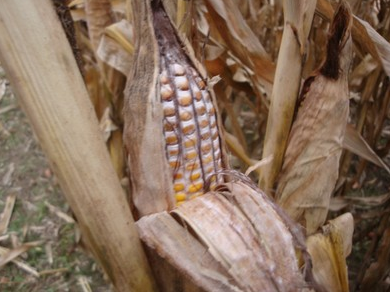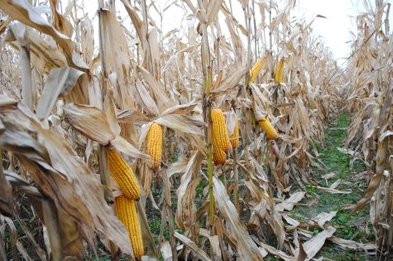As corn harvest nears completion, moldy ear problems have been reported in Northwest Ohio, especially in certain corn hybrids planted late after June 1. The moldy ears have been attributed to Diplodia and Gibberella fungal infection (Figure 1).
Vomitoxins (associated with Gibberalla) have been found in some of the later planted, wetter corn (>25%). The few preliminary reports received to date suggest that vomitoxin levels are lower and vomitoxin problems far more limited in scope than in 2009.
|
|
This is largely because, compared to 2009, conditions this year were relatively dry during the first few weeks after pollination, which restricted the development of Gibberella ear rot.
Although some level of infection may have occurred at silking, conditions during early grain-fill were in general not favorable for widespread ear rot development and mycotoxin contamination, except in some of the later planted fields. As was the case in 2009, molds have often been associated with upright ears (Figure 2).
Ears that remain erect after physiological maturity (black layer development) are more likely to have ear molds because they trap water, especially at the base of the ear. These ears may also be affected by opportunistic saprophytic organisms taking advantage of the moist, nutritious environment at the base of the ear.
|
|
These saprophytes are usually not associated with vomitoxin production, so not all moldy ears will be contaminated. It is important to first identify the ear mold you are dealing with in order to determine whether you will have a problem with mycotoxins.
There are several factors that determine whether a corn ear remains erect or “droops” (points downward) following physiological maturity. Ears of corn normally remain erect until sometime after physiological maturity has occurred (black layer development), after which the ear shanks eventually collapse and the ears droop (Nielsen, 2011).
However ears may droop in drought-stressed fields that have not yet reached physiological maturity. A loss of turgidity in the ear shank due to water stress, possibly combined with some cannibalization of carbohydrates in the ear shank may eventually cause the ear shank to collapses, resulting in ear drooping. In certain hybrids, ears remain upright following physiological maturity (or remain erect for a longer duration) which can be related to a shorter ear shank.
According to some seed company agronomists, prior to the development of Bt hybrids, corn breeders tried to reduce ear drop due to European corn borer damage by shortening ear shanks. Much of that germplasm has continued to be used in more recent hybrids.
These agronomists acknowledge the concerns that upright ears are slower to dry or more prone to ear molds and indicate that companies are looking for more droopy shanks to help protect ears from water damage. However they contend that there are other genetic components to these traits and that the effects of upright ears on fungal infections may not be as pronounced as is widely thought.
In addition to genetic differences among hybrids, environmental conditions and cultural practices may affect ear orientation during the drydown period prior to harvest. In a 2010 OSU field study that compared 16 hybrids varying in maturity from 101 to 118 days relative maturity at two locations, differential responses to plant population for % ear erectness (at maturity) were observed.
At S. Charleston, growing conditions were favorable and yields averaged 235 bu/A. At Hoytville, yields averaged 134 bu/A due to drought stress. At S. Charleston, % erect ears decreased as plant population increased - 93%, 74% and 49% at 18,000, 30,000, and 43,000 plants/A, respectively. At Hoytville, % erect ears remain basically unchanged with increase in plant populations (ranging from 88% to 86%). These results suggest that factors other than hybrid genetics can determine if an ear is in an erect or droopy position at harvest.

 Figure 1. Moldy ears from a 2011 NW Ohio corn field that was associated which tested positive of vomitoxins (Source: Glen Arnold, OSU Extension)
Figure 1. Moldy ears from a 2011 NW Ohio corn field that was associated which tested positive of vomitoxins (Source: Glen Arnold, OSU Extension) Figure 2. Droopy and erect ears in OSU Defiance County 2011 test plot. Only 15% of the ears were erect at harvest but nearly all were moldy whereas no mold was visible in the droopy ears (Source: Bruce Clevenger, OSU Extension)
Figure 2. Droopy and erect ears in OSU Defiance County 2011 test plot. Only 15% of the ears were erect at harvest but nearly all were moldy whereas no mold was visible in the droopy ears (Source: Bruce Clevenger, OSU Extension)




Post a comment
Report Abusive Comment